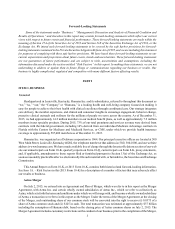Humana 2015 Annual Report Download - page 21
Download and view the complete annual report
Please find page 21 of the 2015 Humana annual report below. You can navigate through the pages in the report by either clicking on the pages listed below, or by using the keyword search tool below to find specific information within the annual report.13
Provider Arrangements
We provide our members with access to health care services through our networks of health care providers whom
we employ or with whom we have contracted, including hospitals and other independent facilities such as outpatient
surgery centers, primary care providers, specialist physicians, dentists, and providers of ancillary health care services
and facilities. These ancillary services and facilities include laboratories, ambulance services, medical equipment
services, home health agencies, mental health providers, rehabilitation facilities, nursing homes, optical services, and
pharmacies. Our membership base and the ability to influence where our members seek care generally enable us to
obtain contractual discounts with providers.
We use a variety of techniques to provide access to effective and efficient use of health care services for our
members. These techniques include the coordination of care for our members, product and benefit designs, hospital
inpatient management systems, the use of sophisticated analytics, and enrolling members into various care management
programs. The focal point for health care services in many of our HMO networks is the primary care provider who,
under contract with us, provides services to our members, and may control utilization of appropriate services by directing
or approving hospitalization and referrals to specialists and other providers. Some physicians may have arrangements
under which they can earn bonuses when certain target goals relating to the provision of quality patient care are met.
We have available care management programs related to complex chronic conditions such as congestive heart failure
and coronary artery disease. We also have programs for prenatal and premature infant care, asthma related illness, end
stage renal disease, diabetes, cancer, and certain other conditions.
We typically contract with hospitals on either (1) a per diem rate, which is an all-inclusive rate per day, (2) a case
rate or diagnosis-related groups (DRG), which is an all-inclusive rate per admission, or (3) a discounted charge for
inpatient hospital services. Outpatient hospital services generally are contracted at a flat rate by type of service,
ambulatory payment classifications, or APCs, or at a discounted charge. APCs are similar to flat rates except multiple
services and procedures may be aggregated into one fixed payment. These contracts are often multi-year agreements,
with rates that are adjusted for inflation annually based on the consumer price index, other nationally recognized inflation
indexes, or specific negotiations with the provider. Outpatient surgery centers and other ancillary providers typically
are contracted at flat rates per service provided or are reimbursed based upon a nationally recognized fee schedule such
as the Medicare allowable fee schedule.
Our contracts with physicians typically are renewed automatically each year, unless either party gives written
notice, generally ranging from 90 to 120 days, to the other party of its intent to terminate the arrangement. Most of the
physicians in our PPO networks and some of our physicians in our HMO networks are reimbursed based upon a fixed
fee schedule, which typically provides for reimbursement based upon a percentage of the standard Medicare allowable
fee schedule.
The terms of our contracts with hospitals and physicians may also vary between Medicare and commercial business.
A significant portion of our Medicare network contracts, including those with both hospitals and physicians, are tied
to Medicare reimbursement levels and methodologies.
Automatic reductions to the federal budget, known as sequestration, took effect on April 1, 2013, including aggregate
reductions to Medicare payments to providers of up to 2% per fiscal year. Due to the uncertainty around the application
of these reductions, there can be no assurances that we can completely offset any reductions to the Medicare healthcare
programs. See “Legal Proceedings and Certain Regulatory Matters” in Note 16 to the consolidated financial statements
included in Item 8. – Financial Statements and Supplementary Data.
Capitation
We offer providers a continuum of opportunities to increase the integration of care and offer assistance to providers
in transitioning from a fee-for-service to a value-based arrangement. These include performance bonuses, shared savings
and shared risk relationships. For some of our medical membership, we share risk with providers under capitation
contracts where physicians and hospitals accept varying levels of financial risk for a defined set of membership, primarily
HMO membership. Under the typical capitation arrangement, we prepay these providers a monthly fixed-fee per
























